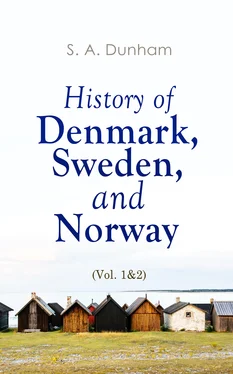But if the multitude were thus deluded, Fengo was not. For his own safety he felt that the youth must be removed; but to effect this some management was required. He would not exasperate his wife, still less the sovereign of Denmark, by openly executing the prince. The deed must be secret, and done by other than native hands, namely, by those of the English king, who, we are gravely assured, was a tributary of Denmark. Before Hamlet’s departure, he privately desired his mother, in one year from that time, to celebrate his funeral obsequies; assuring her, however, that he would in one year return. Two creatures of Fengo were his companions. One night, while they were buried in sleep, he examined their baggage, and found, carved on wood, the mandate to the English king. With his usual cunning, he erased a portion of the characters; and so altered the rest, that the foreign king was to put his two companions to death, but to show every possible kindness towards himself , and even to give him the hand of an English princess. On their arrival in England, they presented their wooden mandate, which they were unable to read; and were invited, with much parade of hospitality, to the royal table. But while the two messengers were thus deluded, Hamlet was received with much respect. The more curious reader may consult the venerable authority before us for an account of what passed at the English court—an account as minute as it is romantic. To be brief: the two messengers were executed; and Hamlet, whose wisdom was so much admired, obtained the hand of the monarch’s daughter. He pretended, however, to be much affected by the death of his companions; and to pacify him, the king gave him a considerable quantity of gold, which he melted and inclosed in the hollow of two walking sticks. At the expiration of the year, he obtained leave to revisit his native country; but, of all his riches, he took only the staves which contained the gold. On reaching Jutland, he assumed his own motley garb, and reached the house of his uncle at the very time his funeral rites were performed. At first, his sudden appearance terrified the domestics and guests; but terror yielded to mirth when they saw him resume his motley character. “Where are your two companions?” demanded they. “Here they are!” was his reply, as he produced his two sticks. Soon he joined the cup-bearers; and as his long flowing garments interfered with his activity, he girt his sword round him, but it had no scabbard; and to impress all the guests with a stronger notion of his insanity, he frequently grasped the blade until the blood flowed from his fingers. Little did they suspect his object in thus descending to the meanest occupation: it was to make all of them beastly drunk, and then to exact his revenge. So well did he succeed in the first intention, that most of them, being unable to stagger from the apartment, were compelled to remain all night in the hall of entertainment. At length, all being buried in sleep, he cut off the cords which supported a huge curtain that occupied the whole room: as it fell on the drunken sleepers, by his wooden hooks he fastened it in many places to the ground; and drawing the cords over the curtain, so bound them by knots and hooks as to bid defiance to the efforts of drunken men. Startled by the weight no less than by the sudden difficulty of breathing, they strove to raise the curtain, but in vain; it was too well secured to be moved. In this state they were soon enveloped in flames, which consumed them and the palace. Fengo retired to his bedroom, and fell asleep: he was awakened by Hamlet, who, after upbraiding him for his various crimes, put him to death. He then flew to a safe retreat to watch the progress of events. Great was the surprise of the Jutes at this disaster; but, as Fengo was a tyrant, the majority were not displeased. Hamlet, therefore, reappeared; surrounded himself with those whom he knew to be attached to the interests of his family; sought the public assembly; and, by his eloquence, so wrought on the people, that they unanimously declared him the successor of Fengo. [57]
Into the remaining adventures of Hamlet—all equally wonderful with the preceding—we cannot enter. Whoever may wish to read his subsequent visit to Britain; his marriage with a second wife, the queen of Scotland; his quarrel with the British king, the father of his first wife; his domestic life with both in his hereditary government of Jutland; his war with Wiglet, king of Denmark, the successor of his grandfather, Ruric; his death in battle; and the facility with which the idol of his heart, his second wife, passed into the arms of the victor, must consult the venerable Saxo. [58]
We have no wish to pursue farther the list of Danish kings, who, according to Saxo, reigned prior to our Saviour’s birth. Some of them, probably, never reigned at all. Others, certainly, reigned after that event. Others, again, ruled at the same time, over different provinces of the kingdom. The reigns of many whom Saxo places before the Christian era are identical with those which the best Danish writers regard as posterior; and the actions attributed to both are substantially the same. All writers admit that Denmark had no monarch before Skiold, the son of Odin; indeed, it had none for some generations afterwards: for there is room to believe that even his authority was more of a sacerdotal than of a temporal character. In virtue of this character he might, and probably did, claim a twofold sovereignty over the peninsula and islands; but that sovereignty was never virtually exercised—it was one merely nominal. Several of the islands had their separate governors, whom Saxo calls kings; and Jutland, as we have seen in the sketch of Hamlet’s life, had them also. The men whom personal qualities elevated above the rest, became chiefs; and when one chief had others subject to him, he assumed the regal title. There were kings of various kinds. We read of petty kings (sma-konungur, or fylke-konungur); of sea kings, island kings, and cape kings. The name of the last may require an explanation. They were neither more nor less than the pirate chiefs, who lived in caverns or in huts near the promontories, ready, at any moment, to sally forth and seize the unsuspecting mariner. Thus there were kings enough scattered over the seas, the forests, the mountains, the maritime coasts of the north. Probably all those in the Danish islands might yield a nominal homage, at least, to the one that reigned in Scania in Zealand. But no dependence whatever can be placed on the list of Danish kings prior to what we now call the historic times; that is, to about the eighth century of our era. It is astonishing to see how little judgment has been exercised by the historians of this country in regard to the old northern kings. Thus, the authors of the “Universal History,” not satisfied with giving the names of the sovereigns from Dan to Frode III., have been so far misled by the Latin historians of Denmark, as to fix the precise year before Christ when each began his reign. [59]
But later writers have made sad work with this list. They contend that some of the names are altogether fabulous; that Skiold reigned only forty years before Christ; Frode I., thirty-five years after Christ; Wermund, one hundred and fifty; Roe and Helge, in the fifth century of our era. The truth, however, is, that while no dependence is to be placed on the genealogical series of the former, very little is due to the latter. The whole, prior to the eighth century, is one mass of confusion. If the names of many princes are to be found, not merely in the earliest writers of the north, but on Runic inscriptions, no power of criticism can fix the period in which they reigned. All is pure conjecture; and one system is preferable to another, only so far as it is more reconcilable to common sense. Yet, while we thus reject some of the ancient sovereigns whom Saxo and the elder chroniclers have handed down to us, we are not so sceptical as to reject the majority. If, prior to Odin’s arrival, the north had no monarchs, it had kings, or, if the reader pleases, chiefs, whose office was sometimes hereditary, sometimes elective. It would, perhaps, be more accurate to say that, while they succeeded by hereditary right to the domains of their predecessors, as generals and judges , they were elected by the free-born warriors. Of these some were, beyond all doubt, elevated into monarchs by tradition; from tradition they passed into the songs of the Scalds; and from these songs their memory was perpetuated by the old chroniclers. For this reason we have not consigned them to total oblivion. Nothing is more easy than scepticism; but if scepticism be, as it assuredly is, allowable in regard to many details, it is no less blameable than credulity, when it rejects the whole substance of history. On the whole, the safest conclusion is, that, while some of Saxo’s kings are imaginary—while many which he places before, doubtless reigned after, our Saviour—while he has confounded the whole order of succession, so as hopelessly to perplex the reader—a few, probably, lived and reigned before the establishment of the Gothic dynasty. [60]
Читать дальше












